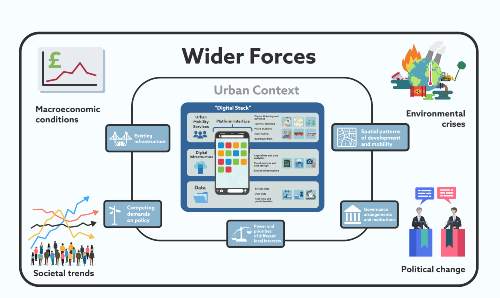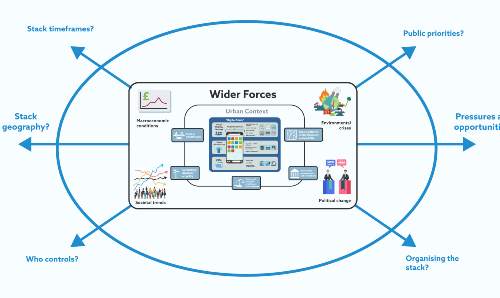The Urban Digital Stack
Digital platforms are prevalent across today’s urban transport system, providing multiple services, including shared mobility, journey-planning, ticketing and payment.
Although there has been substantial research engagement with the implications of platforms for urban transport systems, much of this has been either technical in its focus or has concentrated on individual or small numbers of platforms, rather than on large numbers of platforms operating in a place at the same time.
There is, therefore, a research and policy need to better understand what the implications of multiple platforms are for existing urban public transport systems. In particular, there is a need for frameworks to help urban policymakers and decision-makers think about, debate and respond to the social, political and organisational challenges presented to existing urban public transport systems by the increasing prevalence of digital mobility platforms. Watch this short video for an introduction to the Urban Digital Stack.
What is the Urban Digital Stack?
Responding to this challenge, we have developed the concept of the Urban Digital Stack. The stack provides a multi-layer framework for urban policymakers to think about how multiple platforms should be organised in relation to existing urban public transport systems.
The idea of the stack and urban stack is not new. It has been used in software studies to understand platforms as layered technical configurations. It has also been adapted by social scientists (e.g. Mattern, 2014; Shapiro, 2021) to include social and political, as well as technical, understanding of platforms.
We extend stack thinking to include how multiple platforms can be shaped and organised by existing urban decision-makers and public transport systems. We focus on (1) how platforms can add to the existing landscape of urban public transport systems, (2) what social and political challenges this raises for the control of existing and digital forms of infrastructure, and (3) the implications of this for the organisation of data.
The stack does not provide simple prescriptions, it is a heuristic tool. Its purpose is to help urban policymakers and decision-makers to think about and to debate key challenges and questions with colleagues and other stakeholders and to support them in developing strategies and plans for responding to the challenge of digital mobility platforms. It can be used to communicate strategy in policy documents or presentations.
Key questions for policymakers: the six steps
How should the stack be used as a framework? We propose a six-step process that address a series of fundamental challenges and questions about how platforms can be organised in relation to existing urban public transport systems. The process can be used by urban policymakers and decision-makers in strategy meetings and workshops, and to facilitate communications with colleagues and other stakeholders.
The project
The Urban Digital Stack has been developed as part of the UK ESRC-funded project ‘Digital Platforms and the Future of Urban Mobility’, and is based on the findings of in-depth research in three English urban areas. Data was collected through 75 interviews with key stakeholders, extensive desk-based research and literature reviews, and regular attendance at industry events. Our particular focus was to understand the role and impact of digital platforms on urban transport at a systemic level, and how risks and opportunities might be addressed.
If you found the Urban Digital Stack useful or interesting, the project team would welcome any feedback and further discussion. [michael.hodson@manchester.ac.uk]


